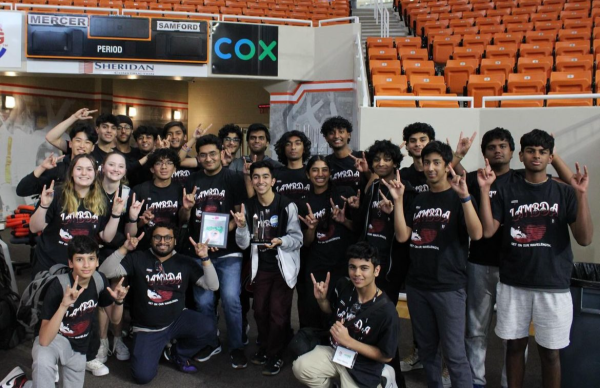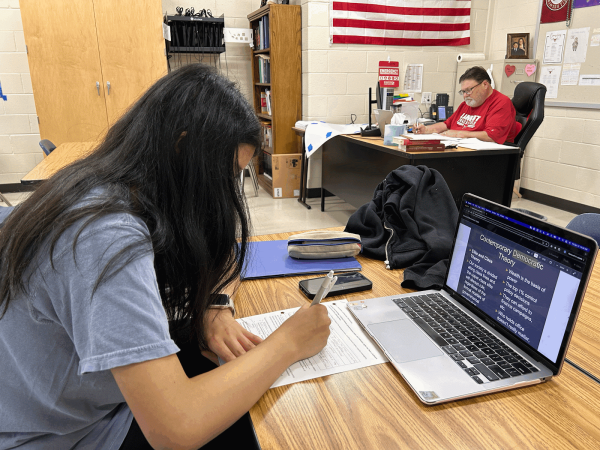The United States’ attendance crisis

The Lambert Attendance Office staff hard at work making sure thousands of students are accounted for every day.
Skipping class is a popular pastime for many high school students. It sets students back in lessons and affects the whole class because they often have to accommodate for them by waiting days to finish projects and assignments, which is more time until they can start new material. Schools try to enforce rules to stop inappropriate absences, but they can’t keep track of every high school student at all times. There is also the problem of chronic absence, when students miss 15 or more days of school.
From a 2012 study, United States schools show an average of 91.7 percent attendance per day in secondary schools, which includes middle and high school grades. That means that the average student misses about 10 percent of their school year. The highest daily attendance ratings were tied between Indiana and North Dakota at 95.5 percent. The lowest state attendance rating for secondary schools was 75.1 percent in New Hampshire. That means that the average student in the state missed about a quarter of their school year. The figure could also be affected by outliers, students who refuse to show up to school will greatly influence that score. Academics can be seriously affected by having almost a quarter of students not show up everyday.
Georgia’s state secondary school average daily attendance for 2012 was unavailable, but its 2008 rating was 93.1 percent. This was exactly 2 percent higher than the national average for that year. Most states retained very similar percentages from 2008 to 2012 in secondary schools therefore it is assumed the data is similar to the most recent school year, 2015-2016.
Lambert Assistant Principal Russ Chesser revealed that Lambert High School’s daily attendance percentage for the 2015-2016 school year was 85 percent in an interview. This score was relatively low compared to Georgia’s overall average daily attendance in 2008, but Lambert was ranked one of the highest in the area for this statistic.
Chronic absences, however give a better description of how often absences are causing disadvantages to academic learning. One study researched the percentages of chronic absences in school districts around the U.S. showed how many outliers exist in many regions of the country. These outlier students miss 15 or more days of school, enough to affect their academics critically as well as skew the data for the average daily attendance of schools which was talked about above. State percentages are very broad, and when you get to more specific regions such as school districts, appalling results will come up. Washington had 119 school districts with an average of 30 percent or more students with chronic absence in the 2013-2014 school year. Washington had more than a third of its 322 school districts have a grossly high number of chronic absences.
Lambert tries to avoid as much chronic absences as possible. Students become a statistic for the Board of Education each time they are counted absent for the fifteenth time. Attendance may be less important than the test scores of a local school, but colleges will still pay attention to it. Students at Lambert applying for college will have a higher chance than students at other schools because of Lambert’s high positive evaluations by colleges and the Board of Education. Therefore the less chronic absences that occur at a school, the better their applications look to potential universities.
According to Mr. Chesser, Lambert’s main deterrent to students skipping school and unnaturally raising our attendance percentages is a positive environment. Lambert’s Principal, Gary Davison does not want students to fear punishment for skipping school. Instead he and the rest of the administrative staff believe in creating a welcoming atmosphere at Lambert that results in students enjoying the chance to come to school. Besides traditional classroom education, Mr. Chesser believes school is where students will learn social and life skills they will need once they graduate. They try to make Lambert as comfortable as possible with passionate projects such as the new Spirit App, spectacular pep rallies, the support for a huge amount of extracurricular activities, and a much longer lunch period than the other schools in the area.
The school systems need to prevent the high absences that are occurring in our country. Chronic absences cripple students in all their classes. Any kind of unexcused absences contribute to a less educated population and lower test scores in a competitive global market. Students that achieve a chronic absence status are less likely to pursue higher education after high school. These all lead to a population with less money and more problems. The United States school system is responsible for delivering an education to our youth. Lambert High School however is fulfilling this responsibility with excellence, and making it so that students come to school just because they want to.
Your donation will help support The Lambert Post, Lambert High Schools student-run newspaper! Your contribution will allow us to purchase equipment and cover website hosting costs.













